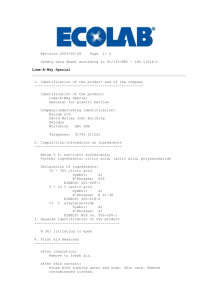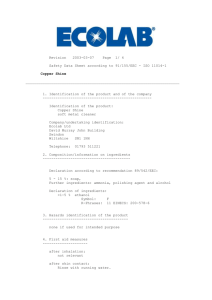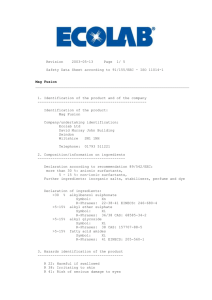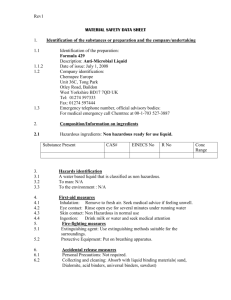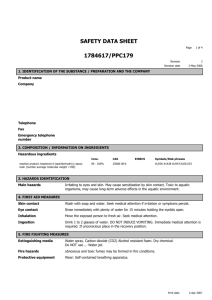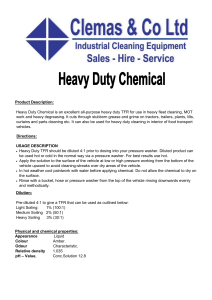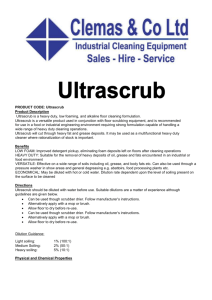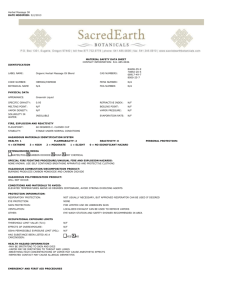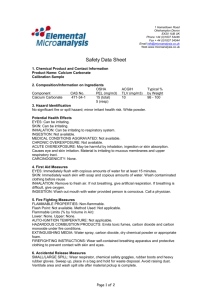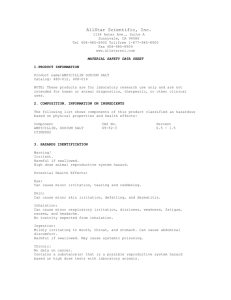Revision 2005-06-29 Page 1/ 5 Safety Data Sheet according to 91
advertisement
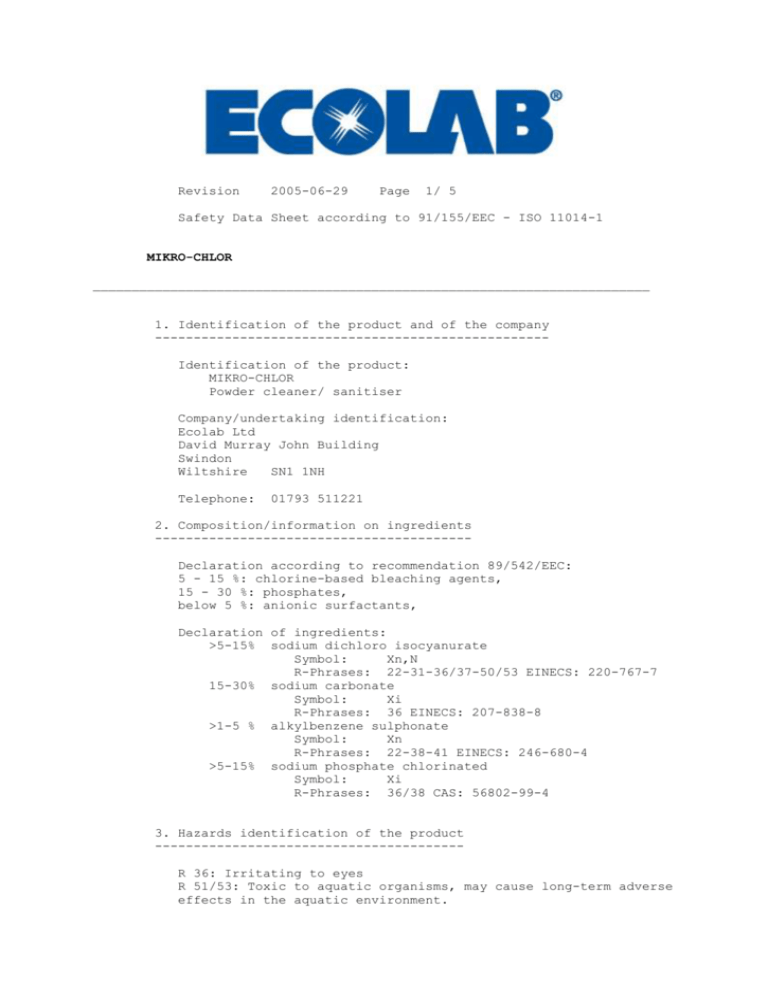
Revision 2005-06-29 Page 1/ 5 Safety Data Sheet according to 91/155/EEC - ISO 11014-1 MIKRO-CHLOR ________________________________________________________________________ 1. Identification of the product and of the company --------------------------------------------------Identification of the product: MIKRO-CHLOR Powder cleaner/ sanitiser Company/undertaking identification: Ecolab Ltd David Murray John Building Swindon Wiltshire SN1 1NH Telephone: 01793 511221 2. Composition/information on ingredients ----------------------------------------Declaration according to recommendation 89/542/EEC: 5 - 15 %: chlorine-based bleaching agents, 15 - 30 %: phosphates, below 5 %: anionic surfactants, Declaration of ingredients: >5-15% sodium dichloro isocyanurate Symbol: Xn,N R-Phrases: 22-31-36/37-50/53 EINECS: 220-767-7 15-30% sodium carbonate Symbol: Xi R-Phrases: 36 EINECS: 207-838-8 >1-5 % alkylbenzene sulphonate Symbol: Xn R-Phrases: 22-38-41 EINECS: 246-680-4 >5-15% sodium phosphate chlorinated Symbol: Xi R-Phrases: 36/38 CAS: 56802-99-4 3. Hazards identification of the product ---------------------------------------R 36: Irritating to eyes R 51/53: Toxic to aquatic organisms, may cause long-term adverse effects in the aquatic environment. Revision 2005-06-29 Page 2/ 5 Safety Data Sheet according to 91/155/EEC - ISO 11014-1 MIKRO-CHLOR ________________________________________________________________________ 4. First aid measures --------------------after inhalation: Remove to fresh air. after skin contact: Rinse with running water. after eye contact: Immediately flush eyes with copious amounts of running water (for 10 minutes), see an oculist. after ingestion: Drink 1-2 glasses of water, seek immediate medical attention. 5. Fire-fighting measures ------------------------Suitable extinguishing media: suitable for all regular extinguishing materials Extinguishing media which must not be used for safety reasons: none known Special exposure hazards arising from the product itself, from combustion products or from resulting gases: none known Special protective equipment for firefighters: no special measures necessary; 6. Accidental release measures -----------------------------Personal precautions: not required Environmental precautions: Do not allow large amounts to be released into the sewer system. Methods of cleaning up/of removing: wash away residue with plenty of water; Revision 2005-06-29 Page 3/ 5 Safety Data Sheet according to 91/155/EEC - ISO 11014-1 MIKRO-CHLOR ________________________________________________________________________ 7. Handling and storage ----------------------Handling: no special measures required Storage: keep container tightly sealed and store in a frost-free place; Do not store together with edibles or other consumable substances. 8. Exposure controls / personal protection -----------------------------------------Components with specific control parameters: none Personal protection: Hand protection: Use suitable protective gloves made from nitrile rubber. Please observe the glove manufacturer's instructions on permeability and rupture times as well as the specific workplace conditions. Eye protection: protective goggles 9. Physical and chemical properties ----------------------------------Physical state: Colour: Odour: powder red of chlorine Frost sensitivity: under 0 Flash point: >100'C Solubility: (20'C) soluble in water 'C 10. Stability and reactivity ---------------------------Conditions to avoid: No decomposition if used according to specifications Materials to avoid: none known if used for its intended purpose Hazardous decomposition products: none known Revision 2005-06-29 Page 4/ 5 Safety Data Sheet according to 91/155/EEC - ISO 11014-1 MIKRO-CHLOR ________________________________________________________________________ 11. Toxicological information ----------------------------Eye contact: Irritating to eyes 12. Ecological information -------------------------Persistence and degradability: This product contains surfactants which are at least 90 % biodegradable by reference to the German regulation June 4, 1986. 13. Disposal considerations --------------------------May be disposed of via the municipal waste-water system in compliance with local authority regulations. 14. Transport information ------------------------UN 3077 Environmentally hazardous substance, solid, n.o.s. (dichloroisocyanuric acid, dihydrated sodium salt), 9, III 12 x 500g pack is LQ 15. Regulatory information -------------------------Classification and labelling according to Chemicals Hazard Information and Packaging Regulations (CHIP): Symbols of danger: Xi Irritant N Dangerous for the environment R-phrases: R 36: Irritating to eyes R 51/53: Toxic to aquatic organisms, may cause long-term adverse effects in the aquatic environment. S-phrases: S 25: Avoid contact with eyes S 26: In case of contact with eyes, rinse immediately with plenty of water and seek medical advice S 60: This material and its container must be disposed of as hazardous waste Revision 2005-06-29 Page 5/ 5 Safety Data Sheet according to 91/155/EEC - ISO 11014-1 MIKRO-CHLOR ________________________________________________________________________ National regulations: The Control of Substances Hazardous to Health Regulations Health and Safety at Work Act 16. Other information --------------------This information is based on our current level of knowledge and relates to the product in the state in which it is delivered. It is intended to describe our products from the point of view of safety requirements and is not intended to guarantee any particular properties. Full text of the R-phrases indicated by codes in this safety data sheet. The product code/identification/designation is indicated in Section 15. R 22: Harmful if swallowed R 31: Contact with acids liberates toxic gas. R 36: Irritating to eyes R 36/37: Irritating to eyes and respiratory system. R 36/38: Irritating to eyes and skin. R 38: Irritating to skin R 41: Risk of serious damage to eyes R 50/53: Very toxic to aquatic organisms, may cause long-term adverse effects in the aquatic environment.
